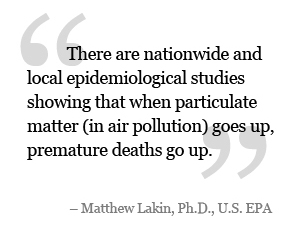Myths & Facts
Wood smoke is natural, so it must be okay.
We tend to think that substances that are ‘natural’ are harmless, but this isn’t true.
Asbestos, tobacco, and uranium are just a few of the natural substances that are harmful to human health.
Even though humans have burned wood since the beginning of time, scientists have only recently discovered just how hazardous wood smoke pollution is to our health.
The negative health effects of residential wood smoke have now been extensively documented in hundreds of scientific studies. The pollution generated by wood burning has been linked to a litany of health problems that include asthma attacks, diminished lung function, respiratory ailments, heart attacks, and stroke.
Aren’t there more important environmental issues to worry about?
When it comes to air pollution, not really.
In many locations, such as the San Francisco Bay Area, wood burning is the single largest source of hazardous particle pollution during winter, creating even more particle pollution than vehicles and industry.
In many areas, wood burning is also one of the most significant sources of toxins such as dioxin.
Unlike highly regulated industrial sources of pollution, wood burning occurs right in the neighborhoods where we live—sometimes right next door. This means that people can be subjected to levels of hazardous pollution from wood burning that are far higher than from any other pollution source.
Wood smoke pollution is only a problem for people with asthma.
While the pollution from wood burning is especially dangerous for those with existing health conditions, children, and the elderly, it is hazardous to the health of all human beings.
Studies have shown that even in young, healthy people, exposure to the particle pollution produced by wood burning causes inflammation of the lungs and decreases lung volume.
While the hazardous health effects of wood burning pollution increase with the levels in the air, scientists have found that there is no level of particle pollution that is not unhealthful.
The basic rule of thumb is this: if you can smell wood smoke, you’re breathing pollution that is hazardous to your health.
EPA certified woodstoves are the solution.
While it is true that EPA certified wood stoves may produce less particulate air pollution than uncertified ones when new and operated according to manufacturer specifications, they produce orders of magnitude more particulate pollution than appliances that burn natural gas.
In addition, the stated performance of EPA certified wood stoves degrades with use to the point where the particulate emissions are comparable to non-certified wood stoves.
Another key issue: EPA certified wood stoves emit highly toxic dioxins at levels equal to, or even greater, than levels emitted by conventional wood burning devices.
Wood smoke rises, so what’s the problem?
Most of the harmful pollutants from wood burning don’t rise. They hang around at ground level for up to ten days.
On cold winter days (when people tend to burn wood) the problem is even worse, because the weather conditions create temperature inversions that put a lid over the lower atmosphere, trapping hazardous pollutants close to ground level.
I can just shut my windows and I’ll be fine.
The fine particle pollutants from wood burning are so small that they infiltrate even the most well-insulated and weather-stripped homes. Scientific studies have shown that particle pollution levels inside homes reach up to 70% of the pollution levels outdoors.





